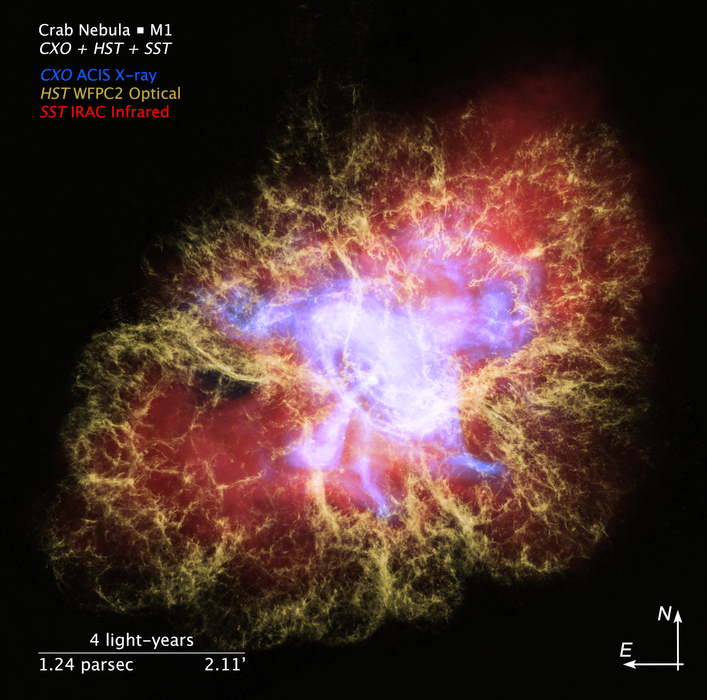NASA released the video above on January 5, 2020, saying it was created by astronomers and visualization specialists from its Universe of Learning program. These experts combined visible, infrared and X-ray vision of the famous Crab Nebula, the remains of a star that exploded into view in Earth’s sky in the year 1054. The video shows images from the Chandra X-ray Observatory and the Hubble and Spitzer space telescopes. It shows the pulsar at the heart of the Crab Nebula – the rapidly spinning, super-dense crushed core of the exploded star – which sends high-energy jets in either direction into the nebula, and which serve as what NASA calls the powerhouse “engine” of the entire system. In a statement, NASA said:
The tiny dynamo [the pulsar] is blasting out blistering pulses of radiation 30 times a second with unbelievable clockwork precision.
The visualization was produced by a team at the Space Telescope Science Institute (STScI) in Baltimore, Maryland; the Caltech/IPAC in Pasadena, California; and the Center for Astrophysics | Harvard & Smithsonian (CfA) in Cambridge, Massachusetts. It debuted earlier this month at the American Astronomical Society meeting in Honolulu, Hawaii.
EarthSky 2020 lunar calendars are available! Only a few left. Order now!

STScI’s visualization scientist Frank Summers led the team that developed the video. He said:
Seeing two-dimensional images of an object, especially of a complex structure like the Crab Nebula, doesn’t give you a good idea of its three-dimensional nature. With this scientific interpretation, we want to help people understand the Crab Nebula’s nested and interconnected geometry. The interplay of the multiwavelength observations illuminate all of these structures. Without combining X-ray, infrared, and visible light, you don’t get the full picture.
NASA described the video this way:
The movie begins by showing the Crab Nebula in context, pinpointing its location in the constellation Taurus. This view zooms in to present the Hubble, Spitzer, and Chandra images of the Crab Nebula, each highlighting one of the nested structures in the system. The video then begins a slow buildup of the three-dimensional X-ray structure, showing the pulsar and a ringed disk of energized material, and adding jets of particles firing off from opposite sides of the energetic dynamo.
Appearing next is a rotating infrared view of a cloud enveloping the pulsar system, and glowing from synchrotron radiation. This distinctive form of radiation occurs when streams of charged particles spiral around magnetic field lines. There is also infrared emission from dust and gas.
The visible-light outer shell of the Crab Nebula appears next. Looking like a cage around the entire system, this shell of glowing gas consists of tentacle-shaped filaments of ionized oxygen (oxygen missing one or more electrons). The tsunami of particles unleashed by the pulsar is pushing on this expanding debris cloud like an animal rattling its cage.
The X-ray, infrared, and visible-light models are combined at the end of the movie to reveal both a rotating three-dimensional multiwavelength view and the corresponding two-dimensional multiwavelength image of the Crab Nebula.
Summers commented:
The three-dimensional views of each nested structure give you an idea of its true dimensions. To enable viewers to develop a complete mental model, we wanted to show each structure separately, from the ringed disk and jets in stark relief, to the synchrotron radiation as a cloud around that, and then the visible light as a cage structure surrounding the entire system.
These nested structures are peculiar to the Crab Nebula. They reveal that the nebula is not a classic supernova remnant as once commonly thought. Instead, the system is better classified as a pulsar wind nebula. NASA explained:
A traditional supernova remnant consists of a blast wave and debris from the supernova that has been heated to millions of degrees. In a pulsar wind nebula, the system’s inner region consists of lower-temperature gas that is heated up to thousands of degrees by the high-energy synchrotron radiation.
Read about how this video was made

Bottom line: A new NASA video combines visible, infrared and X-ray views of the famous Crab Nebula, a star that exploded into view in our sky 1,000 years ago.











